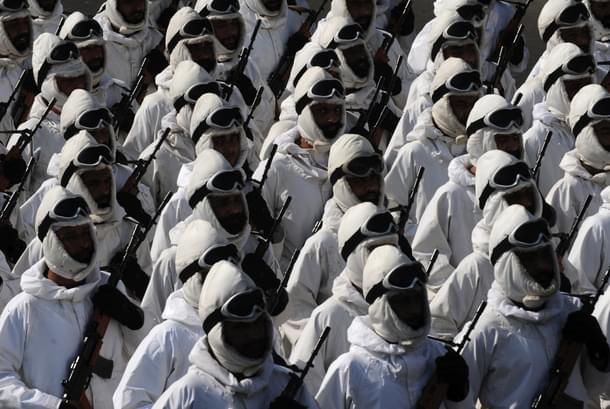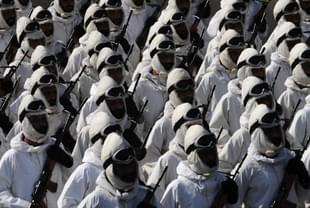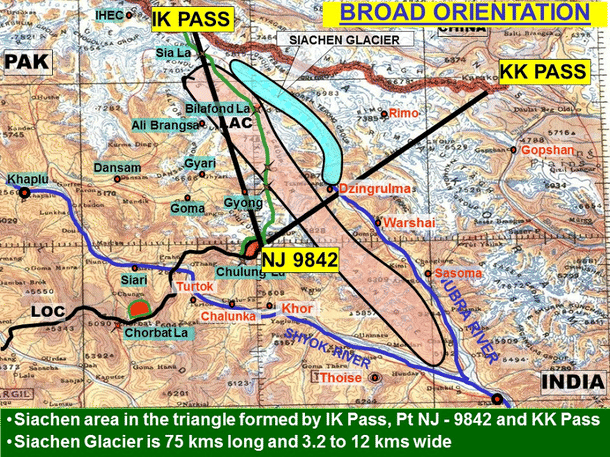Books
Siachen: The Strategic Inevitability
Syed Ata Hasnain
Feb 14, 2016, 12:20 PM | Updated 06:27 PM IST
Save & read from anywhere!
Bookmark stories for easy access on any device or the Swarajya app.


L/Nk Hanumanthappa’s miraculous rescue and most regretful demise despite prayers of a billion people left the nation emotionally shattered. Rare are occasions when all Indians rally emotionally behind an event or a personality. It also led to a very appropriate media hype which was needed and an attempt by the media to look for the right people who deserved credit even in the face of disaster.
The events led to some ill-informed speculation about the worth of retaining our hold over Siachen. It ranged from potential total withdrawal to mutual pull back in agreement with Pakistan. Ideas were also generated about satellite and other electronic surveillance means to keep a watch over the icy wasteland. Figures of 300 million USD annual expenditure and 890 lives lost over the last 30 years added to the arguments.
The media did a fine job and discussions were serious without hyperbole. At least the public was showing interest in a strategic security issue as was evident from social media and an element of inquiry was in the air. The perceptions of those who favored status quo were based more on patriotic concerns and mistrust of Pakistan and not any solid strategic reasoning.
What the nation and its leadership needs is a clear vision of the threats posed by the vacation of Siachen and China-Pakistan collusion. It must also ask itself what has changed which demands an alteration in our security perceptions. The threat to life and limb from vagaries of climatic conditions has existed ever since the glacier was occupied. Does the emotional connect with soldier casualties necessitate the vacation of national interest?
The location of Siachen Glacier needs a geo strategic-analysis afresh. The wedge of territory between NJ 9842, Karakoram Pass and the Shagsgam Valley is the bone of contention (see map).

MAPS ARE ONLY INDICATIVE AND FOR PURPOSES OF UNDERSTANDING AND DO NOT REPRESENT ACTUAL OR PROJECTED BOUNDARIES (click for full screen)
Our claim for the LoC is the line along the Saltoro ridge which separates the 76 km long Siachen Glacier from the Konduz Galcier to the West. Pakistan claims that the LoC should run from NJ 9842 to Karakoram Pass thus laying claim to the Saltoro Ridge and the Siachen Glacier. Due to pro-active occupation of Saltoro and the denial of all passes to Pakistan for access to the sub glaciers since 1984, India has virtually sealed Pakistan’s fate. Pakistan has no visibility over the glacier and has been desperate for a toehold on the Saltoro in the vicinity of the passes so as to have a ‘peep’ at Siachen. All hype about Siachen in Pakistan is to project what the Pakistan Army wishes to sell back home. The sales pitch is to brand India the aggressor, draw moral support and promote a perception that its troops are deployed at Siachen.
India’s line of defence against Pakistan’s threats is along the Saltoro, which does not end at the snout of the glacier but continues to flow south and south-west towards Turtuk and Chalunka in the valley below. Against China it is in the East Karakoram Range and continues into the plains towards Aksai Chin. If we were to give up the Saltoro and pull back, the next line of defence cannot lie in the Shyok and Nubra Valley; that is where the delaying elements would be deployed, the covering troops, so to say. The next line would have to be the Ladakh Range on which the two major passes, Khardungla and Chang La exist. That’s a stone throw from Leh and the Leh Valley.
Siachen Glacier is the source of the Nubra River that flows into the the Shyok River which in turn flows into the Indus. Water resources are weapons of last resort and if nothing else their control strengthens deterrence.
In 1963, post the disastrous Sino-India border conflict, Pakistan was emboldened to illegally hand over 5000 square km of territory in the Shaqsgam valley to China. This valley lies at the north-eastern tip of Gilgit Baltistan (GB). Although Siachen itself has no direct connect with Shaqsgam its northern tip at Indira Col can facilitate approach to it. The China–Pakistan strategic connect therefore remains narrow and given the potential infrastructural build up in the sector, after the decision to construct the China Pakistan Economic Corridor (CPEC), the desire to broaden this connect through a larger swathe would always be present rather than leaving it to a sliver of territory.
The boundary of Gilgit Baltistan with China is long but the northern parts are all impassable and uninhabitable. Our presence in the Siachen sector would prevent this broadening of useable terrain contact. Given the state of fragility of borders in Ladakh, both with Pakistan and China anything which risks future status should be avoided by us.
The investment that India is making in expensive infrastructure for the security of Daulat Beg Oldi (DBO) is all north of the Ladakh Range. Thus it would make no strategic sense to weaken our defensive posture in the Nubra/Siachen sector while strengthening the same in the East Karakoram area.
Gilgit Baltistan is a part of J&K state and as per the Instrument of Accession of 26 October, 1947, the entire territory of the state of J&K belongs to India. Thus Gilgit Baltistan forms a part of the territories that come under the scope of the Joint Resolution passed by both Houses of India’s Parliament on 22 February, 1994. The CPEC which also entails presence of China’s PLA troops in Gilgit Baltistan, for its protection, is violative of all norms of disputed territories. India’s deployment in Siachen sector is on the flank of the CPEC and gives us flexibility in future negotiations.
India’s earlier stance had always been the need for authenticating the Actual Ground Position Line (AGPL), both sides of which troops of the Indian and Pakistan Armies are deployed, before any mutual withdrawal could be considered and agreed upon. The AGPL is a virtual extension of the LoC north of NJ 9842. Its authentication has always been resisted by the Pakistan Army because that would belie its claims of being in Siachen.
There have been reports that after the massive avalanche at Gyari in 2012, which buried 138 Pakistani soldiers, the Pakistan Army was willing to authenticate the AGPL to facilitate mutual withdrawal. This has led to ideas being generated even on our side that mutual withdrawal should be executed and technology be exploited to monitor any violations in the virtual no man’s land that will be created.
It needs to be realized that any withdrawal to lower heights while benefitting us in terms of reduction in loss of lives and expenditure, compromises our position of dominance enjoyed by our deployment at the Saltoro Ridge. Even if surveillance and early warning devices give us indicators of reneging of the agreement by Pakistan, our response time in glaciated terrain cannot counter such intent. There are far too many people situating the issue to desert terrain where reactions are almost lightning in speed. It has taken us years of experience and toil to establish a fool proof logistics system which supports the deployment. That cannot be duplicated at a whim if we ever have to return to the heights again.
Last, is the issue of trust. Pervez Musharaf’s recent rants on television, irritating as they are, should give us enough indications of what we are up against. Subterfuge, double speak, denial and backstabs are a part of Pakistan’s military-diplomatic posturing. There is never uniformity of policy, or continuity and progression of any process. The foreign and defence policy remains obfuscated due to multiple controls of the Deep State. We are dealing with a nation where leaderships welcome breakthroughs in neighbourly relations on a given day and sponsor proxy terror attacks six days later. In such an environment, can a strategic deployment which has matured over 30 years of experience be compromised?
Without taking away anything from the sacrifice of the ten bravehearts of 19 Madras, there could be occasions when such tragedies may occur again and the expenditure will continue as before. Yet, India cannot afford to fritter the strategic advantage it has gained through the years even though emotional constraints and factors may dictate many reviews. The principle of boots in defence of national borders hasn’t yet reached a point where it can be rescinded.
The writer is a former GOC of India’s Srinagar based 15 Corps, now associated with Vivekanand International Foundation and the Institute of Peace and Conflict Studies.




